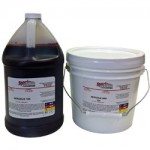Resorcinol Formaldehyde Glue
 Resorcinol Formaldehyde Glue is also called just resorcinol glue. It is an old glue that has been around forever in the marine industry. Over the years it has slowly been replaced by modern day epoxy’s.
Resorcinol Formaldehyde Glue is also called just resorcinol glue. It is an old glue that has been around forever in the marine industry. Over the years it has slowly been replaced by modern day epoxy’s.
Resorcinol is a simple molecule of benzene with 2 hydroxy bits. It’s produced either by using a natural resin such as a distillate of Brazilwood and combining it with potassium hydroxide, or by several synthetic methods. It is then further treated to produce its wonderful adhesion.
The advantages to Resorcinol:
- It is waterproof. It is one of a few glues that can hold together wood that is fully submerged under water. The glue has been used for years in the marine industry.
- It resists acids, saltwater, solvents, oils, and most other things. It is sensitive to alkalis.
- Its a strong glue. Currently it is used to put together plywood, laminated support beams, and othe structural wood elements
- Known for its long term reliability
- Can withstand a wide range of temperatures. Does not
 soften when warm, does not creep, and does not get brittle in sub-zero temperatures. Also works in a wide range of humidity areas
soften when warm, does not creep, and does not get brittle in sub-zero temperatures. Also works in a wide range of humidity areas - Can be used on oaks and oily woods.
- Pot life after mixing can be several hours.
- Metal surfaces can be bonded with proper preparation and primer.
The disadvantages of Resorcinol glue is:
- Poor gap filling properties
- Joints and laminations must be clamped and pressed tightly. Sometimes for several hours to allow glue to set.
- Short shelf life
- Comes in 2 parts and mixed before use.
- Glue line is dark brown/red.
- Toxic until it is cured. Can be irritating to eyes, respiratory system, and skin.
- Not readily available
- Has a higher VOC than other adhesives.
- Hard to clean up cured glue
- Expensive
